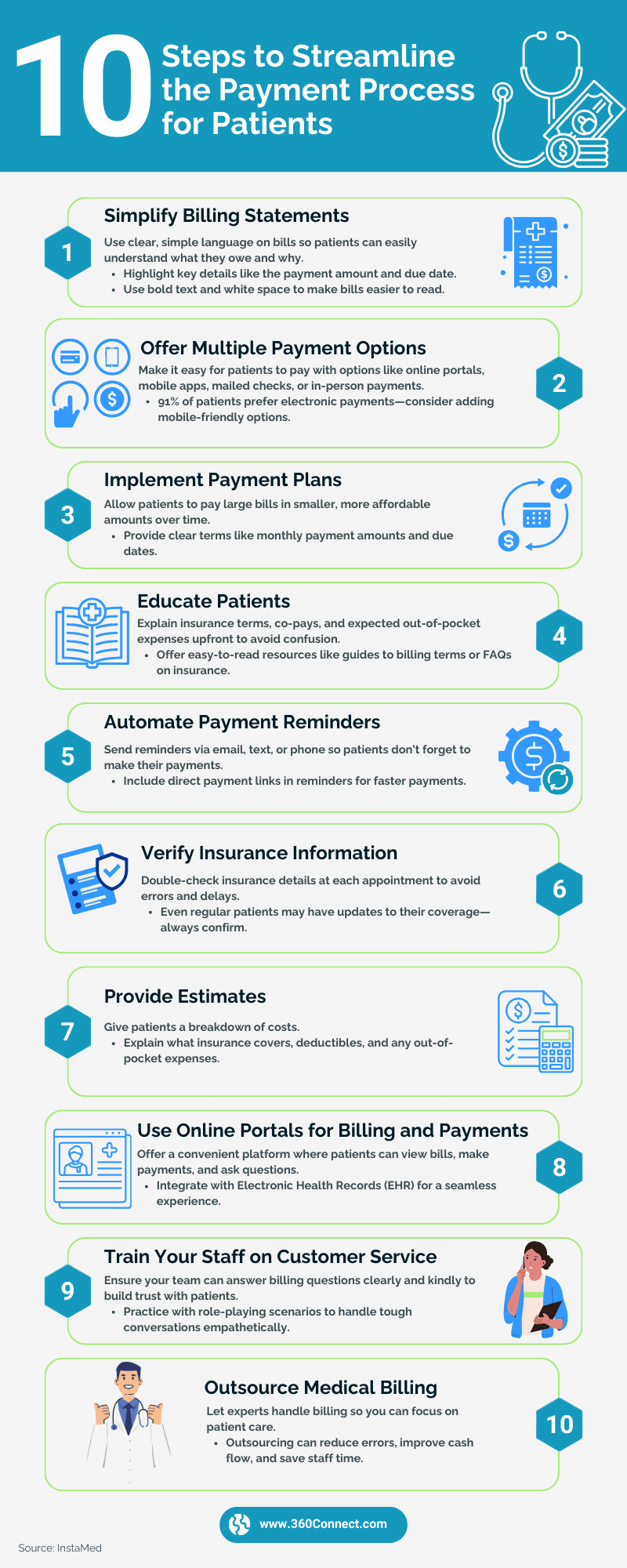When it comes to medical billing, one of the biggest hurdles is determining how to streamline the payment process for patients. For many medical billing professionals, the payment process can be slow, frustrating, and confusing for patients. If you’re tired of experiencing long waits for payments or countless calls from patients trying to understand their bills, it may be a good time to revamp and streamline your payment process.
Streamlining the payment process isn’t just possible—it’s essential for your practice’s bottom line and your patient’s satisfaction. In this blog, we’ll share 10 actionable steps you can take to simplify patient payments, minimize delays, and reduce headaches for everyone involved.
Addressing Medical Billing Errors: The Real First Step to Streamline the Payment Process for Patients
Before we dive into the 10 steps to streamline the payment process for patients, let’s talk about one of the biggest barriers to faster payments: billing errors. Studies show that a staggering 80% of medical bills in the U.S. contain errors. These mistakes—whether they’re typos, coding inaccuracies, or incorrect patient information—don’t just frustrate patients; they slow down the entire billing process and increase the likelihood of payment disputes.
The reality is that before you can expect patients to pay promptly, your practice needs to ensure bills are accurate. Double-checking billing details, implementing quality assurance processes, and keeping up with coding updates are critical steps to reducing errors. Think of it this way: accuracy isn’t just about avoiding errors—it’s about building trust.
Addressing billing errors is the first and most important step toward streamlining the payment process. Once your internal systems are in order, you’ll be better positioned to implement the strategies outlined below and see real results.
Now, without further ado, let’s dive into the 10 steps to streamline the payment process for patients.
10 Steps to Streamline the Payment Process for Patients

1. Simplify Billing Statements
Have you ever had a patient call your office saying, “I don’t understand this bill”? (We’re sure sometimes your staff hears more colorful language, but for the sake of keeping it professional, let’s assume that’s all they ever hear.) Complex or unclear billing statements are one of the biggest reasons payments are delayed. When patients can’t decipher what they’re being charged for, it creates frustration and uncertainty—two emotions that are likely to put their payment on hold.
To simplify billing statements, use clear, patient-friendly language and avoid medical jargon whenever possible. Break down charges into easy-to-understand categories, explain terms like deductibles or co-insurance, and clearly display the payment amount and due date. Formatting also matters—use larger fonts for important details, bolded sections for key takeaways, and white space to keep the document from looking overwhelming. (Pro tip: yellow highlighting works wonders)
By making your bills straightforward and approachable, you reduce confusion and make it easier for patients to pay promptly. Not only does this improve cash flow for your practice, but it also enhances the patient experience, fostering trust and satisfaction with your services, and overall helps streamline the payment process for patients.

2. Offer Multiple Payment Options
Patients have different preferences when it comes to paying their medical bills and accommodating these differences can significantly improve payment rates. Some may prefer the convenience of online payments for ease of use and others may prefer in-person payment for peace of mind. Both options should be available. And yes, even in today’s times, you’ll still have some patients who only feel comfortable mailing in a check.
91% of consumers favor electronic payment methods for medical bills.
Note: While it’s helpful to provide flexibility, encouraging patients to pay upfront—either partially or in full—can greatly reduce the risk of non-payment. For example, implementing systems to collect co-pays or deposits before appointments can improve cash flow and save your office from having to chase down payments later. Pair this with clear communication about payment options to help patients plan ahead.
Overall, by offering multiple payment options, you eliminate barriers to payment and make the process as seamless as possible. The easier you make it to pay, the less likely payments are to fall through the cracks. Consider offering the following payment methods to meet patient needs:
- Online payment portals
- Mobile payment apps
- Credit and debit card payments
- Mailed checks
- In-person payments at your office
3. Implement Payment Plans
Piggybacking off of offering multiple payment options, you may want to offer payment plans. For many patients, paying a large medical bill upfront simply isn’t an option. Offering flexible payment plans can bridge this gap, allowing patients to pay their balance over time in manageable installments. This not only reduces the financial burden on patients but also ensures your practice receives the payments it’s owed, even if it takes a little longer.

The key to successful payment plans is clear communication. From the start, outline the terms, including the total amount, monthly payment amount, due dates, and any associated fees or interest. Transparency helps patients feel confident about their payment arrangement and reduces the likelihood of misunderstandings or disputes. Additionally, automated reminders—via text, email, or both—can help patients stay on track and prevent missed payments.
By offering this option, you provide a patient-friendly solution that encourages consistent cash flow for your practice while showing patients you’re willing to work with them during financially challenging times. Everyone wins, and you’ve helped streamline the payment process for patients.
4. Educate Patients
One of the main reasons patients feel blindsided by medical bills is a lack of understanding about their insurance coverage and out-of-pocket costs. Many patients don’t fully grasp how deductibles, co-pays, and insurance limits work, leading to confusion and frustration when they receive their bill. Taking time to educate patients during the intake process can prevent these issues and set the stage for smoother payments.
During intake, provide a clear breakdown of the patient’s financial responsibilities. Explain how their insurance works, what their deductible covers, and what portion of the costs they’ll be expected to pay out-of-pocket. Be proactive by addressing common billing scenarios and offering estimates when possible. When patients understand what to expect financially, they’re more likely to pay on time and avoid disputes.
To support these efforts, consider providing easy-to-read educational documents that patients can take home or access online. Recommended resources include:
- A guide to understanding medical billing terms (e.g., deductible, co-pay, co-insurance)
- Step-by-step explanation of how insurance claims are processed
- FAQs about payment options and financial assistance
5. Automate Payment Reminders
Sometimes, all patients need to stay on top of their bills is a little nudge. Automated payment reminders are a simple yet effective way to ensure patients don’t forget upcoming payments. By using automation tools, you can send reminders via email, text, or even phone calls, giving patients a heads-up that their payment is due. These reminders are especially effective when they include a direct link to your payment portal, making it quick and easy for patients to settle their balance with just a few clicks.
Not only do automated reminders improve on-time payments, but they also save your staff valuable time. Instead of manually tracking and following up on outstanding balances, your team can focus on higher-priority tasks while the system handles the gentle nudges for you.
Recommended Automated Payment Reminder Methods:
- Phone Calls: Use automated voice messages for friendly reminders.
- Email: Include a clear subject line, a personalized message, and a link to your payment portal.
- Mail: For patients who prefer traditional methods, send pre-scheduled reminder letters with payment details and an envelope to make it easier for them to pay right away.

6. Verify Insurance Information
Incorrect insurance information is one of the leading causes of billing errors and claim denials, as well as the delays that follow. That’s why verifying insurance details during every single patient visit is a must, even for long-time patients. Sure, you’ve seen Mr. Smith for years, but insurance plans change, policies lapse, or employers switch providers. Assuming nothing has changed can lead to headaches for both your staff and the patient.
Taking a few minutes to confirm insurance details upfront may seem like a small step, but it can save you countless hours of chasing down corrections or re-submitting claims later. Patients will appreciate the proactive approach too—no one likes dealing with the surprise of denied claims or unexpected bills.
By making this a standard part of your check-in process, you can eliminate avoidable errors, keep billing workflows smooth, and help streamline the payment process for patients.
7. Provide Estimates
Few things frustrate patients more than receiving a bill for medical services that is significantly higher than expected. Imagine a patient coming in for a routine procedure, expecting to pay their co-pay, only to be blindsided weeks later with a hefty bill that exceeds their monthly budget. These surprise medical bills can not only delay payments but also damage trust in your practice.
To avoid this situation, providing cost estimates before appointments is encouraged. For example, if a patient is scheduled for an imaging procedure, take the time to break down the expected costs: what insurance will likely cover, their deductible responsibility, and any out-of-pocket expenses. Presenting this information upfront gives patients a clear understanding of their financial responsibility and helps them plan accordingly.

Providing estimates might require an extra step in your workflow, but the benefits far outweigh the effort. By investing in this practice, you’re not only improving the client experience but also helping streamline the payment process for patients.
8. Use Online Portals for Billing and Payments
Online portals have revolutionized medical billing by giving patients a centralized, user-friendly platform to manage their payments. These portals allow patients to view their bills, make payments, and even set up payment plans—all from the comfort of their own home. Many also include built-in messaging features for billing inquiries, which can significantly reduce the number of phone calls your team needs to handle.
What makes online portals even more powerful is their integration with Electronic Health Records (EHR) and Electronic Medical Records (EMR) systems. These systems provide patients with a seamless experience by linking billing information directly to their medical records. Patients can access their medical history, billing details, and educational resources all in one place, reducing confusion and ensuring they have a complete view of their healthcare journey.
Related: EHR vs. EMR: 5 Key Differences
Benefits of Online Portals to Streamline the Payment Process for Patients:
- Easy-to-use interface for patients: Simple navigation helps patients quickly find and manage their bills.
- Central location for medical documents: Patients can access bills, receipts, and other financial records in one place.
- Comprehensive view of financial responsibilities: Portals often include educational resources to help patients understand their costs.
- Efficient messaging system: Patients can send billing questions directly through the portal, and your team can respond quickly.
9. Train Your Staff on Customer Service
When a patient receives a bill they were not expecting, chances are they will be ringing the phone off the hook. After receiving their bill, patients will typically contact your office for billing inquiries. And we won’t sugarcoat it…they usually aren’t in the best mood. These moments are high-stakes: patients may be confused, frustrated, or overwhelmed, and how your staff handles these interactions can make or break their trust in your practice. A well-trained, empathetic team can turn these potentially stressful conversations into opportunities to build loyalty and resolve issues efficiently.
Start by ensuring your staff has a thorough understanding of your billing systems, insurance processes, and payment plans. They should be able to confidently and clearly explain charges, address patient concerns, and offer solutions like setting up payment plans when necessary. Just as important is their ability to communicate with empathy—patients need to feel heard and respected, especially in sensitive financial discussions. A simple statement like, “I completely understand how this might be confusing, let me explain,” can de-escalate frustration and build goodwill.

Tips: Investing in regular training is key. Role-playing exercises can help staff practice handling tough conversations, while quick-reference guides can ensure they have answers at their fingertips. By equipping your team with both knowledge and soft skills, you create a smoother experience for patients, reduce billing disputes, and foster stronger relationships.
Related: How to Handle Late Patient Payments
10. Outsource Medical Billing
Managing medical billing in-house can quickly become a logistical nightmare. Between chasing down late payments, resolving claim denials, and staying on top of ever-changing insurance regulations, it’s a lot for any practice to handle. These tasks not only consume valuable time, but also leave room for costly errors that can impact your revenue cycle.
Outsourcing medical billing to a trusted partner simplifies the entire process. Professional billing companies are experts in navigating insurance complexities, submitting clean claims, and following up on unpaid accounts. They can also provide detailed reporting to keep you informed without the burden of micromanaging every step. With these tasks off your plate, you and your staff can focus on what truly matters—delivering quality patient care.
By outsourcing, you gain the peace of mind that your billing is being handled efficiently and accurately. It’s a strategic move that can improve cash flow, reduce administrative stress, and streamline the payment process for patients.
Related: How Much Does a Medical Billing Service Cost?
Why Outsourcing Medical Billing is the Best Way to Streamline the Payment Process for Patients
Of all the strategies we’ve discussed, outsourcing medical billing stands out as the most impactful way to transform your practice. It’s more than a step—it’s a complete solution that addresses the core challenges of managing patient payments while freeing your team to focus on patient care.
When you outsource, you’re not just improving your billing process; you’re simplifying the entire financial workflow of your practice. By leveraging expert support, you ensure consistent cash flow, reduced stress for your team, and a smoother experience for your patients. If you’re looking for one change that can truly make a difference, outsourcing is the clear choice.

Here are a few options for outsourced medical billing:
Related: In-House vs. Outsourced Medical Billing: Pros & Cons
Final Thoughts on How to Streamline the Payment Process for Patients
Streamlining the payment process for patients doesn’t have to be a daunting task. By implementing these 10 steps, you can reduce delays, improve patient satisfaction, and boost your practice’s financial health. Whether it’s simplifying billing statements, offering online payment portals, or outsourcing medical billing, every improvement you make benefits your patients and your team.
Outsource Your Medical Billing Today
Ready to take the stress out of billing? 360Connect can connect you with trusted medical billing professionals who specialize in helping practices like yours streamline payment processes.
Get 5 FREE Quotes today and discover how outsourcing can transform your billing process.

